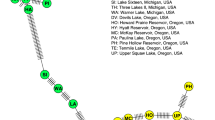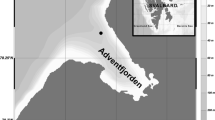Abstract
Sardinian man-made lakes are reservoirs of species richness, hosting zooplankton taxa from the Mediterranean region and North Africa. To provide a first record of the taxa composition and diversity of zooplankton communities, we sampled 15 reservoirs during 2008–2009, from the north of the island to the south, representative of a range of size, depth, renewal time, and trophy. The survey was complemented by seasonal sampling in one of the largest lakes studied. Water samples collected from surface to bottom provided data on hydrochemistry and trophy. Crustacean dormant stages were inspected from sediments of the richest, and most diverse, Lake Sos Canales. RDA suggested that productivity, water depth, renewal time and altitude were the main variables related to taxa composition. The ubiquitous Copidodiaptomus numidicus, and its persistence in the water column, resulted from the production of subitaneous eggs throughout the year, an adaptive strategy in perennial water bodies. Genetic analyses of DNA sequences of the diagnostic gene ND5 placed the Sardinian Daphnia pulex in the North American group. Moreover, the ND5 sequence found in Sardinia was identical with that of an asexual hybrid clone between the American D. pulex and American D. pulicaria that replaced native D. pulex throughout Africa. The presence of this ND5 haplotype in Sardinia shows that this invasive clone also poses an invasive threat to native populations in Europe.
Similar content being viewed by others
References
Alfonso G., Belmonte G., Marrone F. & Naselli-Flores L. 2010. Does lake age affect zooplankton diversity in Mediterranean lakes and reservoirs? A case study from southern Italy. Hydrobiologia 653(1): 149–163. DOI: 10.1007/s10750-010-0350-4
Alonso M. 1996. Crustacea, Branchiopoda. In: Ramos M.A. et al. (eds), Fauna Iberica, Vol. 7, Museo Nacional de Ciencias Naturales, CSIC, Madrid, 486 pp.
Anisimova M. & Gascuel O. 2006. Approximate likelihood-ratio test for branches: A fast, accurate, and powerful alternative. Syst. Biol. 55(4): 539–552. DOI:10.1080/10635150600755453
Armengol J. 1980. Colonización de los embalses espanoles por crust`aceos plancótnicos y evolución de la estructura de sus comunidades. Oecologia Aquatica 4: 47–78.
Bláha M., Hulák M., Slouková J. & Tešitel J. 2010. Molecular and morphological patterns across Acanthocyclops vernalisrobustus species complex (Copepoda, Cyclopoida). Zoologica Scripta 39(3): 259–268. DOI: 10.1111/j.1463-6409.2010.00422.x
Brooks J.L. & Dodson S.T. 1965. Predation, body size and composition of plankton. Science 150(3692): 28–35. DOI: 10.1126/science.150.3692.28
Calvo S., Barone R., Naselli-Flores L., Fradá Orestano C., Dongarrá G., Lugaro A. & Genchi G. 1993. Limnological studies on lakes and reservoirs of Sicily. Naturalista Siciliano Series IV, Palermo, 17(Suppl.): 1–292.
Caramujo M.J. & Boavida M.J. 2000. The seasonal dynamics of Copidodiaptomus numidicus (Gurney, 1909) and Thermocyclops dybowskii (Lande, 1890) in Castelo-do-Bode Reservoir. Aquat. Ecol. 34(2): 143–153. DOI: 10.1023/A:1009982422411
Cherbi M. 1984. Contributioná l’etude du peuplement zooplanctonique de trios lacs de barrage: Hamiz, Boughzoul et Ghrib. Thèse de Doctorat, Universit`e d’Alger, 216 pp.
Cioglia L., Cottiglia M., Tagliasacchi-Masala M., Rotta B. & Atzeni A. 1969. Osservazioni su un lago artificiale a usi multipli della Sardegna meridionale. Il Lago di Monti Pranu. Rend. Sem. Fac. Scienze Univ. Cagliari 39: 1–32.
Colbourne J.K., Crease T.J., Weider L.J., Hebert P.D.N., Dufresne F. & Hobæk A. 1998. Phylogenetics and evolution of a circumarctic species complex (Cladocera: Daphnia pulex). Biol. J. Limn. Soc. 65: 347–365.
Dahms H.U. 1995. Dormancy in the Copepoda-an overview. Hydrobiologia 306(3): 199–211. DOI: 10.1007/BF00017691
Dahms H.U., Li X., Zhang G. & Quian P. 2006. Resting stages of Tortanus forcipatus (Crustacea, Calanoida) in sediment of Victoria Harbor, Hong Kong. Estuarine Coastal and Shelf Science 67(4): 562–568. DOI: 10.1016/j.ecss.2005.12.011
Dodson S. 1992. Predicting crustacean zooplankton species richness. Limnol. Oceanogr. 37(4): 848–856.
Dussart B.H. 1967. Les Copépodes des eaux continentales d’Europe occidentale, Tome I: Calanoïdes et Harpacticoïdes. Edition N. Boubée & Cie., Paris, 500 pp.
Einsle U. 1993. Crustacea, Copepoda, Calanoida und Cyclopoida. Süßwasserfauna von Mitteleuropa 8/4-1, Gustav Fischer Verlag, 84 pp.
Einsle U. 1996. Copepoda: Cyclopoida: Genera Cyclops, Megacyclops, Acanthocyclops. Guides to the identification of the microinvertebrates of continental waters of the world. Vol. 10. Dumont H.J.F. (ed.), SPB Academic Publishing bv, Amsterdam, 82 pp. ISBN 90-5103-125-4
Felsenstein J. 1985. Confidence limits on phylogenies: An approach using the bootstrap. Evolution 39(4): 783–791.
Gannon J.E. & Stemberger S. 1978. Zooplankton (especially crustacean significance and rotifer) as indicator of water quality. Trans. Am. Micros. Soc. 97(1): 16–35.
Gliwicz Z.M. & Lampert W. 1990. Food thresholds in Daphnia species in the absence and presence of filament. Ecology 71(2): 691–702.
Hairston N.G. 1996. Zooplankton eggs banks as biotic reservoir in changing environment. Limnol Oceanogr. 41(5): 1087–1092.
Hasegawa M., Kishino H. & Yano T. 1985. Dating of the humanape splitting by a molecular clock of mitochondrial DNA. J. Mol. Evol. 22(2): 160–174. DOI: 10.1007/BF02101694
Hobæk A., Manca M. & Andersen T. 2002. Factor influencing species richness in lacustrine zooplankton. Acta Oecologica 23(3): 155–163. DOI: 10.1016/S1146-609X(02)01147-5
Hopp U., Maier G. & Bleher R. 1997. Reproduction and adult longevity of five species of planktonic cyclopoid copepods reared on different diets: a comparative study. Freshwater Biol. 38(2): 289–300. DOI: 10.1046/j.1365-2427.1997.00214.x
Karabin A. 1985. Pelagic zooplankton (Rotatoria and Crustacea) variation in the process of lake eutrophication. I. Structural and quantitative features. Ekol. Pol. 33(4): 567–616.
Maly E.J. 1973. Density, size and clutch of two high altitude diaptomids copepods. Limnol. Oceanogr. 18: 840–848.
Manca M. & Ammiraglio M. 2002. Zooplankton of 15 lakes in Southern central Alps: comparison of recent and past (pre-ca 1850 AD) communities. J. Limol. 61: 225–231.
Marchetto A., Padedda B.M., Mariani M., Lugliè A. & Sechi N. 2009. A numerical index for evaluating phytoplankton response to changes in nutrient level deep mediterranean reservoirs. J. Limnol. 68(1): 106–121.
Margaritora F.G. 1983. Cladoceri (Crustacea: Cladocera). Guide per il riconoscimento delle specie animali delle acque interne italiane. Officine Grafiche Calderini, Bologna, 168 pp.
Margaritora F.G., Champeau A. & Ferrara O. 1975. Contribution á l’étude de la faune des aux stagnantes de Corse. Les Cladoc`eres (crustacés). Revue de biologie et d’`ecologie méditerranéenne II(3): 3–14.
Marková S., Dufresne F., Rees D.J., Černík P. 2007. Cryptic intercontinental colonization in water fleas Daphnia pulicaria inferred from phylogenetic analysis of mitochondrial DNA variation. Mol. Phylogenet. Evol. 44(1): 42–52. DOI: 10.1016/j.ympev.2006.12.025
Marrone F., Barone R. & Naselli-Flores L. 2006a. Ecological characterization and cladocerans, calanoid copepods and large branchiopods of temporary ponds in a Mediterranean island (Sicily, southern Italy). Chemistry and Ecology 22(Suppl. 1): S181–S190. DOI: 10.1080/02757540600557827
Marrone F., Barone R. & Naselli-Flores L. 2006b. Cladocera (Branchiopoda: Anomopoda, Ctenopoda, and Onychopoda) from Sicilian in inland waters: an updated inventory. Crustaceana 78(9): 1025–1039.
Mergeay J., Verschuren D. & De Meester L. 2006. Invasion of an asexual American water flea clone throughout Africa and rapid displacement of a native sibling species. Proc. Roy. Soc. B 22. 273(1603): 2839–2844. DOI: org/10.1098/rspb.2006.3661
Mittelbach G.G., Steiner C.F., Scheiner S.M., Gross K.L., Reynolds H.L., Waide R.B., Willig M.R., Dodson S.I. & Gough L. 2001. What is the observed relationship between species richness and productivity? Ecology 82(9): 2381–2396. DOI: 10.1890/0012-9658(2001)082[2381:WITORB]2.0.CO;2)
OECD 1982. Eutrophication of Waters. Monitoring, Assessment and Control. Organization for Economic Co-operation and Development, Paris, 154 pp. ISBN: 9264122982
Onbé T. 1978. Sugar flotation method for sorting the resting eggs of marine cladocerans and copepods from sea-bottom sediment. Bull. Jap. Soc. Sci. Fish 44: 1411.
Pace M.L. 1986. An empirical analysis of zooplankton community size structure across lake trophic gradients. Limnol. Oceanogr. 31(1): 45–55.
Parra G., Matias N.G., Guerrero F. & Boavida M.J. 2009. Short term fluctuation of zooplankton abundance during autumn circulation in two reservoirs with contrasting trophic state. Limnetica 28(1): 175–184.
Patalas K. 1972. Crustacean plankton and the eutrophication of St. Laurence Great Lakes. Journal of the Fisheries Research Board of Canada. 29(10): 1451–1462. DOI: 10.1139/f72-224
Petrusek A., Seďa J., Machčček J., Ruthová Š. & Šmilauer P. 2008. Daphnia hybridization along ecological gradients in pelagic environments: the potential for the presence of hybrid zones in plankton. Phil. Trans. R. Soc. B 12 363(1505): 2931–2941. DOI: 10.1098/rstb.2008.0026
Petrusek A., Hobæk A., Nilssen J.P., Skage M., Černý M., Brede N. & Schwenk K. 2008. A taxonomic reappraisal of the European Daphnia longispina complex (Crustacea, Cladocera, Anomopoda). Zool. Scripta 37(5): 507–519. DOI: 10.1111/j.1463-6409.2008.00336.x
Pielou E.C. 1966. The measurement of diversity in different types of biological collection. J. Theor. Biol. 13: 131–144. DOI: 10.1016/0022-5193(66)90013-0
Posada D. 2008. ModelTest: Phylogenetic Model Averaging. Mol. Biol. Evol. 25(7): 1253–1256. DOI: 10.1093/molbev/msn083
Rosenzweig M.L. & Abramsky Z. 1993. How are diversity and productivity related? pp. 52–65. In: Ricklefs R.E. & Schluter D. (eds), Species Diversity in Ecological Communities: Historical and Geographical Perspectives, University of Chicago Press, Chicago & London, 414 pp. ISBN 0226718220
Sechi N. & Cossu A. 1979. Prime valutazioni sui livelli trofici di alcuni bacini artificiali della Sardegna. Mem. Ist. Ital. Idrobiol. 37: 259–276.
Sechi N. & Lugliè A. 1992. Limnological studies on man-made lakes in Sardinia (Italy). Mem. Ist. Ital. Idrobiol. 50: 365–381.
Sechi N. & Lugliè A. 1996. Phytoplankton in Sardinian reservoirs. Giornale Botanico Italiano 130: 977–994.
Seďa J., Petrusek A., Macháček J. & Šmilauer P. 2007. Spatial distribution of the Daphnia longispina species complex and other planktonic crustaceans in the heterogeneous environment of canyon-shaped reservoirs. J. Plankton Res. 29(7): 619–628. DOI: 10.1093/plankt/fbm044
Shannon C.E. & Weaver W. 1949. The Mathematical Theory of Communication. The University of Illinois Press, Urbana, Illinois, 144 pp. ISBN 0-252-72548-4
StatSoft Inc. 2001. STATISTICA for Windows (Data Analysis Software System), Version 6. StatSoft, Tulsa, 1098 pp.
Stella E. 1970. Diaptomidi della Sardegna. Rendiconti dell’Istituto Lombardo di Scienze e Lettere. Classe di Scienze Matematici e Naturali. Vol. (B) 104: 69–87.
Stella E. 1982. Calanoidi (Crustacea, Copepoda, Calanoida). Guide per il riconoscimento delle specie animali delle acque interne italiane. Edizioni Calederini, Bologna, 67 pp.
Strickland J.D.H. & Parsons T.R. 1972. A practical handbook of seawater analysis. Fisheries Research Board of Canada, Bulletin 167, 2nd ed., 310 pp.
Størm K. 1946. The ecological niche. Nature 157: 375–375. DOI: 10.1038/157375b0
ter Braak C.J.F. & Šmilauer P. 2002. CANOCO Reference Manual and CanoDraw for Windows User’s guide: Software for Canonical Community Ordination, Version 4.5. Microcomputer Power Ithaca, NY, 351 pp.
Thielsch A., Brede N., Petrusek A., De Meester L. & Schwenk K. 2009. Contribution of cyclic parthenogenesis and colonization history to population structure in Daphnia. Mol. Ecol. 18(8): 1616–1628. DOI: 10.1111/j.1365-294X.2009.04130.x
Tolotti M., Manca M., Angeli N., Morabito G., Thaler B., Rott E. & Stuchlik E. 2006. Phytoplankton and zooplankton association in a set of Alpine high altitude lakes: geographic distribution and ecology. Hydrobiologia 562(1): 99–122. DOI: 10.1007/s10750-005-1807-8
Tundisi J.G., Rocha O., Matsumura-Tundisi T. & Braga B. 1998. Reservoir management in South America. Int. J. Water Resourc. Develop. 14(2): 141–155. DOI:10.1080/07900629849367
Author information
Authors and Affiliations
Corresponding author
Rights and permissions
About this article
Cite this article
Fadda, A., Marková, S., Kotlík, P. et al. First record of planktonic crustaceans in Sardinian reservoirs. Biologia 66, 856–865 (2011). https://doi.org/10.2478/s11756-011-0092-4
Received:
Accepted:
Published:
Issue Date:
DOI: https://doi.org/10.2478/s11756-011-0092-4




